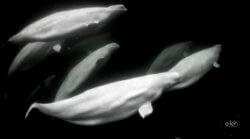Chirp … squawk … trill … tweet! I couldn’t blame you for thinking we’re in the rain forest! But no, actually, we are listening in on beluga whales.
Early mariners called them “canaries of the sea,” owing to their amazing repertoire of vocalizations easily heard through the wooden hulls of ships. Listen more closely and you’ll hear whistles, squeals, creaky doors, pops, grunts and burps – just a sample of the extraordinary soundscape of belugas living life in their native waters.
Distinct populations, some of which are critically endangered, occur all around the Arctic from Canada and Greenland to Norway, Russia and Alaska. The most southerly group lives in the St. Lawrence Estuary. Their scientific name, Delphinapterus leucas, means “white dolphin without a wing” as they have no dorsal fin – nature’s way of making navigating ice easier.

Photo copyright by Ellen Cuylaerts. Used with permission.
Belugas possess some unique abilities. Using their highly evolved echolocation to traverse dark or murky waters and find food, they can manipulate the shape of their rounded foreheads, or melon, to focus a beam of “sonar” in very wide or laser-like narrow bands. The sonar “clicks” bounce back to produce in their large complex brains an “image” of what’s around them. Since, unlike in most cetaceans, the vertebrae in their necks are not fused they can turn their heads much like we do.
One of the world’s smallest toothed whales, adult males typically average 15–18 feet in length, females about 20 percent shorter. In the Arctic, large males are capable of diving to extreme depths of over 2,500 feet, but belugas also routinely enter warmer, shallow estuaries during summer months in groups that can number in the hundreds.
Belugas learn to “say” their own signature sound, much like an acoustic “name tag.”Amid such massive gatherings, you can imagine the vocal cacophony – like an orchestra tuning up – and what a challenge it would be for babies to stay in contact with their moms. However, recent studies show that baby belugas learn to “say” their own signature sound, much like an acoustic “name tag” that can be recognized even in a raucous beluga crowd. And just like human children, it can take up to two years for them to learn to “say” their name perfectly. (See note 1.)
Belugas are cultural animals who pass down vital information to their young, generation after generation. (See note 2.) Spend any length of time studying beluga whales and you soon learn that they have personalities and preferences. They are playful, creative and inquisitive. They show emotion and have feelings, needs and desires.
We’ve barely begun to learn who these amazing, charming and complex beings are. But if I know anything about the wonderfully chatty “canaries of the sea,” it’s that we’ll be hearing much more from them.
Catherine Kinsman is our Site Coordinator in Nova Scotia and co-Founder of the Whale Stewardship Project, which focuses on research and protection of beluga whales.
Note 1. (2018) Vergara V., Mikus M.-A. Contact call diversity in natural beluga entrapments in an Arctic estuary: Preliminary evidence of vocal signatures in wild belugas. Marine Mammal Science, 00(00): 1-32
Note 2. O’Corry-Crowe G, Suydam R, Quakenbush L, Potgieter B, Harwood L, Litovka D, et al. (2018) Migratory culture, population structure and stock identity in North Pacific beluga whales (Delphinapterus leucas). PLoS ONE 13(3): e0194201. https://doi.org/10.1371/journal.pone.0194201